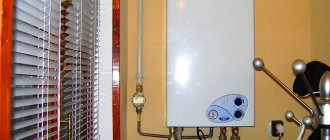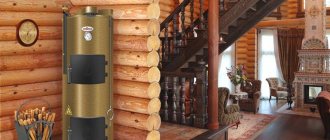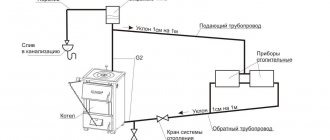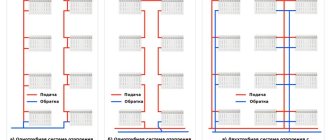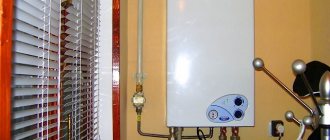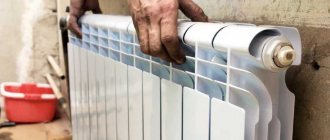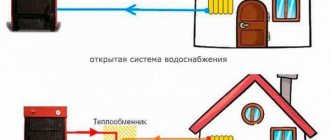Here you will learn how to save on heating in an apartment: an alternative to central heating in an apartment building, additional economical heaters, how to heat a room with a quartz appliance.
What residents of apartment buildings experience when they receive payment receipts at the beginning of the heating season is more like shock than surprise.
The trend of constant upward growth in utility tariffs is causing more and more people to ask the question of how to save on heating in an apartment.
Unfortunately, residents of high-rise buildings have a limited choice, but they still have it.
Installing autonomous heating in an apartment: difficulties
As mentioned above, in the case of a private house everything is much simpler.
Here you can install both a gas and electric boiler, as well as a liquid fuel and solid fuel one. In a private house, no one forbids making a water floor or installing solar panels on the roof, a solar heating collector, or installing a heat pump in the house. Or you can even build a mini-boiler room next to a residential building. But in an apartment, most of the described options are prohibited because:
- not every project is feasible from a practical or technical point of view in a building with many occupants and in a limited area;
- it may harm the interests of neighbors;
- There are legal restrictions on such projects.
So, it is simply not practical to install a solid fuel boiler in an apartment, since there is no necessary room, and there is simply no place to store fuel - firewood or coal. But the floors of buildings are usually not designed for such a significant additional load. Just like storing large amounts of flammable material in a residential area is dangerous.
In apartments of multi-apartment buildings, warm water floors cannot be installed; only an electric version is allowed. However, first of all, when switching to autonomous heating in an apartment building, you have to deal with legal difficulties. Thus, in some regions, the abandonment of central heating is generally prohibited by local regulations.
Autonomous heating system diagram
Therefore, you need to start not with project documentation, but with consultation with a lawyer. After all, it is possible that in order to install autonomous heating in an apartment building, permission will have to be obtained through the court. At the same time, such permission is required both for the refusal of centralized heating and for the installation of autonomous heating.
Reducing heat loss
To avoid suffering from cold in your apartment in the fall, you need to take care in advance to reduce heat loss. Up to 30% of thermal energy is lost through loosely fitting window sashes and doors. Therefore, doors and windows are insulated first. After this, the house will become much warmer.
Modern double-glazed windows, as a rule, provide a high level of tightness. Therefore, there is no need to insulate them additionally. Old wooden frames dry out over time. Large gaps appear in them, through which heat escapes. To seal such window openings, putty, cotton wool, old newspapers, and rags are used.
On a note! To keep warm, you can use plastic film. This material allows sunlight to pass through, but does not allow cold air to penetrate from outside. During the day, it is recommended to open the curtains to let the sun's rays into the room. They will heat the room. At night, the curtains are closed so as not to lose warm air. It is better to use thick and heavy curtains. They provide less heat loss.
When insulating windows, we must not forget about the front door. The door frame is lined with thermal insulation material. An additional insulating layer can be placed in the door leaf. Additionally, it is recommended to install a second door. It will keep the house warm and reduce noise levels.
Another source of heat loss is a balcony or loggia. If you insulate them, you can get double protection from cold and drafts. All surfaces on the balcony are sheathed with special heat-insulating material, and the wooden doors are replaced with modern double-glazed windows. It is advisable to use wooden panels to cover the walls from the inside. They retain heat well, look beautiful and are easy to install.
How can heat supply be provided to multi-apartment residential buildings?
There are two options - to power the heat pipes from the main heating networks or to install an autonomous heating point.
Modern technologies make it possible to provide autonomous heating for a house with many apartments.
Both options are good, but having an individual heating point for several apartment buildings and autonomous heating using energy-saving means will please you more. Why?
Because the distance between the “heating point - consumer” pair is minimized, thereby reducing heat losses along the heating network line. This type of heating is called decentralized or autonomous.
Pros:
A lower percentage of costs for heating and hot water supply of an apartment building - and all because the costs of transportation and delivery of coolant to the end consumer are reduced.
Simply put, the heat supply source is practically nearby, which reduces both the time it takes to supply heat to residential buildings and the percentage of heat losses. This results in a reduction in the costs of maintenance, service and repair of heating systems.
The efficiency of heat supply systems – as a consequence, follows from the previous factor. Since the source of heat supply is nearby, the cost of utility bills for hot water supply and heating is somewhat lower.
Independence from the citywide heating schedule. In other words, while heating has not yet been provided in the city (“because the heating season has not arrived as scheduled”), and the temperature outside is already low, apartment-by-apartment heating from an autonomous heat source will come in very handy.
In addition, each consumer will be able to select the optimal temperature conditions for his apartment - turn off/turn on the heating system only for his apartment, adjusting the level of heat supply.
Lower cost and higher return on investment for new buildings with an autonomous heat supply source.
A separate boiler room in each house will increase the free space in the yard. Click to enlarge.
The presence of “additional free space” within the entire microdistrict. This also contributes to the implementation of housing programs, the construction of new buildings and the development of microdistricts not for heating mains, but for the infrastructure of the districts.
In addition, providing apartment buildings with an autonomous source of heat supply is also possible if the construction area already has an established gas supply system.
Flaws
However, along with the advantages that consumers of decentralized heating and hot water have, there are a number of disadvantages:
- The need for additional space allocated for the construction of an autonomous boiler house.
- Unecological operation of the boiler room. For a gas boiler house operating autonomously, it will be necessary to additionally equip an exhaust gas removal system in order to reduce smoke emissions into the atmosphere as much as possible, obtaining the MPC (maximum permissible concentration) value required by SNiP.
- Price. Since autonomous heating today is not yet as popular and in demand as centralized heating systems, the production of boiler equipment for it has not been put on the conveyor belt. Consequently, prices for decentralized heating and hot water systems are still high.
Is it possible to eliminate the above disadvantages completely or at least reduce them to a minimum? Can. Additional space for an autonomous boiler room can be “found” on the roof of a multi-story building that will be heated.
An increasing number of new buildings are already equipped with a roof boiler room with equipment installed on top and overhead piping.
Of course, the installation of additional equipment will cost, and the decentralized heat supply itself to one apartment building is not cheap, but it will all pay off faster than if the house was simply connected to a centralized heat supply system.
Put the carpet on the floor
Rugs are a proven way to warm up cold floors. And it’s even more comfortable with them.
If your budget allows, it is better to choose a carpet made of natural wool. Such carpets are more pleasant to walk on, they are more environmentally friendly and retain heat better. For example, at IKEA, handmade carpets made from natural materials cost from 3.5 thousand rubles, Persian carpets made from wool - from 10 thousand rubles. At Hoff, the price of wool carpets starts from 4 thousand rubles.
The cost of synthetic carpets at IKEA starts from 600 rubles, at Hoff - from 1 thousand rubles.
Types of decentralized heat supply
Another example of autonomous heating of a multi-storey residential building is a block boiler room, consisting of a separate module. Block or modular boiler rooms can be transported because they are delivered in the form of containers.
The use of modular boiler rooms in an apartment building. Click to enlarge.
Their implementation does not require the construction of a new building specifically for boiler equipment - the entire installation is already “enclosed” in a container, moreover, the module is thermally insulated, and assembly is carried out directly at the manufacturer.
Previously, such blocks were used as heating systems for temporary structures (cabins), but now they are offered (after a number of modifications) as an alternative to centralized heating.
But the best option for autonomous heating is an apartment-by-apartment heating system powered from the main gas pipeline or through the power supply network (depending on the type of boiler), the “core” of which is a wall-mounted boiler (gas or electric).
Why wall-mounted? Because wall-mounted boilers have a number of advantages:
- Easy to install, easy to hang on the wall using a set of fasteners (fasteners must be supplied with the boiler equipment)
- They are light in weight and small in size, do not take up much space in the room
- Given their size, they have good power (10-25 kW) and are able to heat a room up to 100 m2 - and this is quite enough for one four-room apartment
- Available in both single- and double-circuit
If the apartment owner plans to install a wall-mounted gas boiler as heating equipment, then he should check the completeness of the equipment, namely:
- Boiler with two circuits (working for both space heating and domestic hot water)
- Combustion chamber – closed type
- The presence of a fan to provide forced draft (intake of fresh air from the street) and removal of combustion products through the chimney pipe
- Pump for forced circulation of coolant
- Electronic ignition and full automation – for rational use of fuel
In the case of an electric boiler, which also operates according to a dual-circuit scheme (heating + providing the consumer with hot water), there will be much fewer difficulties: you will only have to obtain permission to allocate an additional power supply line, plus coordinate the insertion of forward and return pipes into the general water supply system.
The only exceptions will be electrode boilers without heating elements, which work to heat running water.
Insulate windows
Here are the main reasons for drafts from closed windows:
1. Poor fit of the valves.
This may be, for example, due to wear of the rubber seals or improper operation of the fittings: handles, hinges.
You can tighten the window sash fittings yourself - using a hex key, which you need to turn the trunnions (this is a hexagon on the side of the window sash) so that the seal fits tighter to the frame, explains Stanislav Averkin. You can learn this from a YouTube video or consult a video conference with a specialist, for example, from YouDo or Profi.ru.
If the problem is that the fittings are worn out, then they can be replaced with the help of specialists. There is no need to change the windows themselves for this.
2. Poor quality of installation.
If it blows not from the sashes, but from under the window sill or in the corners, it’s a matter of installation quality, says Stanislav Averkin. In this case, the expert advises to reinstall the windows. For the installation of one window - for example, in the kitchen - you will have to pay about 5 thousand rubles.
If reinstalling the windows is impossible, then all that remains is to insulate them with improvised means. For example, you can use a special sealant (from 100 ₽ per bottle), foam rubber, self-adhesive sealant (from 100 ₽ per piece) or the old method - cotton wool and masking tape. But, according to expert Stanislav Averkin, you shouldn’t do this: it would still be safer to replace the windows with new ones.
Autonomous heating in an apartment building
Is it possible to install autonomous heating in an apartment with your own hands? Although there is no legal ban on autonomous heating, it is still advisable to consult a lawyer, since some heating systems are prohibited. For example, water heated floors cannot be installed in apartments because they can overload the system, thus depriving other residents of the house of heat.
In other cases, you need to collect the necessary documents and present them to local authorities:
- registration certificate for housing;
- application for refusal of central heating;
- title deed;
- diagram of a new heating system;
- consent of all apartment residents.
As a rule, such a seemingly simple request as abandoning central heating and switching to providing heat itself turns out to be a lengthy bureaucratic problem.
Even bigger troubles will be installing autonomous heating in an apartment without the appropriate permission. This can result not only in a large fine, but also in court proceedings, so before you decide to equip your apartment with any heating systems, you need to get advice from the relevant authorities and permission for autonomous heating in the apartment.
Schemes for autonomous heating of an apartment:
Advantages and disadvantages
If permission has already been obtained for autonomous heating in an apartment building, then you can begin choosing an alternative type of heat. This is easier to do if you know the pros and cons of autonomous heating in the apartment.
For the first time, an autonomous apartment heating system appeared in Europe. Due to its clear advantages over centralized methods of heating rooms, it quickly spread throughout the world.
- The main advantage of the system is significant cost savings. The owner of the apartment independently decides when to turn on and when to turn off the heating. For example, today there are thermostats in which you can set a timer for a certain time, which allows you to either completely or partially turn off the system when no one is home, and turn it on half an hour before the residents arrive.
- The owner of the apartment can create the desired microclimate in each room.
- Pay exclusively according to the heating meter and do not depend on utility companies and government tariffs.
When making a choice in favor of alternative heat, you need to find out in advance how much autonomous heating in an apartment costs, and what type of heating will be not only economical, but also effective.
Among the disadvantages of such a system, the following nuances can be noted:
- Regular preventative checks are required once a year, for which you need to call a specialist. This is not that expensive, but still many users either ignore this need or simply forget about it.
- Installing even the best heating radiators for an apartment. You should be aware of possible heat loss. which are often caused by external walls, unheated rooms below or poor-quality glazing.
Today, many construction organizations are building residential apartment buildings with ready-made autonomous heating systems. Such housing is in great demand, as it is somewhat cheaper and allows owners to independently decide which type of heating to choose.
Consumer Reviews
On the forums we came across a large number of positive reviews about various heating options for modern city apartments.
Here is what user Ian writes on the forum “Professional Forum: Home and Dacha” (https://www.forumhouse.ru/threads/78153/):
“Electric radiators are a great economical thing. The savings are achieved through electronics that simply turn off the radiator when the room is hot.”
Indeed, the electric radiator wastes little energy. But it's almost as expensive. After all, not all electric radiators operate autonomously. Therefore, they require constant manual switching on and off.
Forum members also note the advantages of traditional central heating.
On the Sok.forum website ( https://forum.cok.ru/viewtopic.php?f=1&t=20495 ), user Avdeev said that, for example, “In Moscow, the coolant in central heating has become much cleaner, thermostats are working normally " This is evidence that modern metropolitan apartments comply with environmental standards.
On the Neoenerg forum (https://neoenerg.ru/alternative-energy/geothermal/85-otoplenie-teplovymi-nasosami-korsa.-moskva-i-vsya-rossiya.html) heating with heat pumps is vigorously discussed. For example, user Oksana writes that “Even though heat pumps require initial costs, they pay for themselves. This is an excellent alternative to gas, which, by the way, is not yet available everywhere.”
Heat pump
That's right, heat pumps are a good thing, along with gas heating. The costs are low if you use the equipment wisely.
Autonomous heating system: varieties
Autonomous heating using gas is perhaps the most common in Russia today. After all, gas itself is still a fairly cheap fuel. And the principle of operation of such systems is very simple, and it is as follows. A gas boiler is installed, to which heating radiators are connected using pipes. The boiler heats water or other coolant, which naturally or forcibly (using a circulation pump) enters the batteries, which release heat to the premises.
For stable operation of the entire system, you will also need an expansion tank, shut-off valves, as well as temperature sensors and temperature control devices. By the way, such heating can not only provide you with cheap heat, but also with cheap hot water all year round. Savings on this resource can also be doubled. You just need to purchase a double-circuit gas boiler right away.
Double-circuit gas boilers
So, the advantages of such a system are:
- savings on heat compared to centralized heating are several times higher;
- convenience - the boiler can be turned on and off when you need it and control the temperature in the system;
- You can connect heated floors to such a system; and in general it is easy to combine with other heating, for example, electric;
- you can use pipes and radiators that you like; that is, get rid of old and bulky batteries, and install, for example, modern ones, hidden under panels.
However, there are also disadvantages of such autonomous heating:
- gas boilers must be checked and serviced annually;
- If a heating device breaks down, repairing it can cost you a pretty penny;
- You will have to monitor the heating system yourself - check whether the pipes are leaking, whether the radiators are heating up evenly, whether there is air in them, whether the circulation pump is working stably and so on.
However, all this just sounds scary. With proper installation, which is carried out by professionals, when purchasing high-quality elements, you usually don’t have to worry about the operation of such a system and check it only once a year - immediately before the start of the heating season. But what savings every year on heat and hot water!
Heating with electricity, of course, is not as economical, but it is safer and even more convenient, because you do not have to seek permission to install a gas boiler in your apartment. Therefore, in recent years, electric boilers have become more and more popular.
It’s quite easy to understand why, because there are many more options for such heating. So, here it is generally possible not to “fence” entire pipe systems, but to install heating elements directly into the radiators. And there are also electric heated floors, special radiators with high efficiency, convectors, infrared radiation, and so on and so forth.
But not everyone understands that even such heating is more efficient than centralized heating, although in fact, here too the savings are twofold, when using modern devices and proper installation of the entire system. For comparison, we list below the advantages and disadvantages of autonomous heating with electricity. So, the pros:
- a large selection of devices and their capabilities;
- there is no need to supply gas to a house or apartment, or to buy liquid or solid fuel, but any home should already have light;
- the system can be powered, among other things, from alternative energy sources;
- noticeable savings compared to centralized heating;
- safety - you will not be poisoned by gas or combustion products of any other fuel.
Negative points:
When installing, it is important to use powerful wires, and your wiring must withstand them; that is, a separate line will be required; If the electricity goes out, you will also lose heat.
Use an electric blanket or heating pad
An electric blanket, sheet or mattress are bedding items that can be plugged into an outlet and used to heat up your sleeping area. Good appliances have several heating modes that are controlled by remote control - you can change the temperature without getting out of bed. Such accessories can be ordered, for example, on Wildberries (from 2.5 thousand ₽) or Ozon (sheets - from 1.5 thousand ₽, mattresses - from 1.7 thousand ₽, blankets - from 2.8 thousand ₽).
You can also take a heating pad with you to bed. An ordinary rubber heating pad, into which you need to pour boiling water, can be bought for 190 ₽. The cost of electric heating pads, which can maintain heat all night, starts from 700 ₽. As a last resort, you can use the “old-fashioned” method and pour hot water into a plastic bottle - it is better to wrap it in a towel so as not to get burned.
Pipeline layout
While heating engineers are discussing the optimal heating scheme for a central heating house, the issue of proper piping in the house is raised. In modern multi-storey buildings, the heating layout can be implemented according to one of two possible patterns.
Single pipe connection
The first template provides for a single-pipe connection with upper or lower wiring and is the most used option when equipping heating appliances in multi-storey buildings. At the same time, the location of the return and supply is not strictly regulated and can vary depending on external conditions - the region in which the house is built, its layout, number of floors and design. The direct direction of movement of the coolant along the risers can also change. There is an option for the heated water to move in the direction from bottom to top or from top to bottom.
The single-pipe connection is characterized by simple installation, affordable cost, reliability and long service life, but it also has a number of disadvantages. Among them are the loss of coolant temperature while moving along the circuit and low efficiency indicators.
In practice, various devices can be used to compensate for the shortcomings that characterize a single-pipe heating scheme; a radial system can be an effective solution to the problem. It is designed to use a collector that helps regulate temperature conditions.
Two-pipe connection
A two-pipe connection is the second version of the template. A two-pipe heating scheme for a five-story building (as an example) is devoid of the disadvantages described above and has a completely different design than a single-pipe one. When implementing this scheme, the heated water from the radiator does not move to the next heating device in the circuit, but immediately enters the check valve and is sent to the boiler room for heating. Thus, it is possible to avoid loss of temperature of the coolant circulating along the contour of a multi-story building.
The complexity of the connection, which is implied by the two-pipe scheme for connecting a heating battery in an apartment, makes the implementation of this type of heating a long and labor-intensive process, requiring large material and physical costs. Maintenance of the system is also not cheap, but the high cost is offset by high-quality and uniform heating of the house on all floors.
Among the advantages that the two-pipe heating radiator connection scheme provides, it is worth highlighting the possibility of installing a special device - a heat meter - on each radiator in the circuit. It allows you to control the temperature of the coolant in the battery, and by using it in the apartment, the owner will achieve significant results in terms of saving money on utility bills, because he will be able to independently regulate the heating if necessary.
Everyone must pay for common household needs
In residential buildings, it is necessary to heat not only apartments, but also common areas. And all residents will have to do this, regardless of how they heat their apartments. Therefore, even owners of individual boilers will be charged for communal heating.
There are several formulas for such charges: according to standards, according to meters, throughout the year or only in winter. You can pay the management company or supplier under a direct contract. But it is impossible to refuse to pay for communal heating: the Constitutional Court has not canceled this obligation for anyone.
Here is a selection of useful articles on how to correctly pay for heating in an apartment so as not to spend too much:
Autonomous heating: pros and cons
The independence of the system is its main advantage. All advantages and disadvantages are consequences of autonomy.
- The heat supply mode is set according to the wishes and capabilities of the people living in the apartment, and not the capabilities of the communal services of the apartment building. Extend the heating season or make it shorter, turn it off if the home is left for a long time, or set it to a minimum heating level - any option is available and feasible.
- Heating adjustment – the air temperature in the apartment is determined by its occupant. In most cases, an independent system allows you to install a thermostat on each radiator, which makes it possible to create an individual thermal regime.
- Savings - despite the hefty initial costs - if we are not talking about an electric boiler, the costs of heating the apartment and maintaining the system itself are significantly reduced compared to paying for centralized heating services.
- If a double-circuit water heating boiler is installed, year-round independent provision of hot water to the home is possible.
The disadvantages of autonomous heating are associated with the fact of its installation and the need to independently take care of its normal functioning.
- Installation - all elements of the system are purchased independently, installed with your own hands or with the help of specialists. The initial expenses are quite significant. The photo shows the working moment.
- Installation of a heating system involves partial destruction of wall partitions, integrity of floors, and so on. Most likely, after this the home will have to undergo at least cosmetic repairs.
- Device repair and maintenance is carried out by representatives of service centers under various conditions. But in any case, paying for them is only the owner’s problem. Deciding whether this is a disadvantage or an advantage is sometimes difficult.
- Installation of autonomous heating requires permission. Of the above, this circumstance is perhaps the most difficult and tedious, judging by the reviews. However, these requirements are not only a product of bureaucratic activity, but also help prevent the installation of illegal, uncertified equipment, which poses a serious danger to all residents of an apartment building.
The convenience and efficiency of any version of an independent system so far exceeds the cost of effort, time and money for its installation that there can be no two opinions: if the installation is fundamentally possible, then it is worth implementing it without putting it on the back burner.
The fee will be recalculated only for those apartments where the boilers are installed with the projects and legally
In some apartments, boilers for individual heating were installed without permission. The residents did not do the project and did not receive approvals. For example, they installed a boiler not to save money, but because there was not enough heat from the central batteries. Or it is turned off too early, the walls in the house are thin, and the family has small children. For such apartments, the changes will not work: there is a clause about this in the findings of the Constitutional Court and the calculation formulas.
You can avoid paying for heating only if all the requirements for reconstruction are met, there are permits and everything is agreed upon.
Requirements
It is necessary that the unit has all the appropriate fasteners:
- Flame presence control.
- Monitoring traction and temperature indicators.
- If there is no fire, the shut-off valve should operate.
Therefore, it is better to buy boilers from those manufacturers who have been on the market for more than one year. Also, annual maintenance must be carried out by the relevant authorities, and this cannot be waived. Today, gas distribution stations not only carry out the gas supply procedure, but also offer high-quality boilers at affordable prices. In this case, they are already fully responsible for the entire process of operation of the device.
Independent heating - what is independence?
The main task that residents of a city apartment who have expressed a desire to become independent from centralized heating may face is obtaining permission. Without official documents allowing you to disconnect from central heating and a ready-made project for future autonomous heating in the apartment, it is impossible to dismantle the equipment.
Important! Unauthorized actions to turn off and dismantle central heating elements in the premises of an apartment building may be regarded as an administrative offense. If such facts are revealed, the apartment owner is forced not only to pay a fine, but also to restore the dismantled equipment at his own expense.
In the process of solving organizational issues, the development of the project should not be left for later. In other words, if you decide to install decentralized heating in your apartment, you will have to decide in advance which type of autonomous heating to give preference to.
The concept of “independent” in relation to a city apartment looks very conditional. Unlike a private house, where the owner has great technological capabilities, a city apartment has limited resources. In private households, you can install autonomous heating of almost any type. If the homeowner has the desire and certain finances, it is possible to truly achieve complete independence from centralized energy suppliers.
The main advantages of independent heating systems are as follows:
- the ability to independently adjust the heating intensity of residential premises;
- quick start and quick shutdown of autonomous heating systems;
- a real opportunity to achieve savings on energy costs;
- Maintaining the optimal permissible temperature in the apartment at any time of the year.
The presence of intra-building communications, the layout of apartments and strict technical standards do not allow apartment owners in an apartment building to use stove and air heating, and other alternative heating options. In this case, you have to be content with gas or electricity. Any interruptions in energy or gas supplies will reduce all your independence to zero. The only thing that can be done is to equip autonomous home heating using one of the main sources, and keep the second as a backup option.
Note: when submitting documents to disconnect from central heating, you will have to attach an alternative heating project for your apartment. The choice of energy sources is not large; the project can be designed for the installation of gas heating equipment or electric. Any other independent heating options will not be approved and will be rejected.
Replace windows
It is better to replace low-quality or old windows (for example, wooden ones with huge cracks) with new ones.
You shouldn’t skimp on windows and installation and don’t rush to make a choice, warns Stanislav Averkin. Otherwise, there is a risk of installing poor quality profiles and not feeling the difference - then you will have to overpay again for a replacement. “If you don’t have enough money for quality materials, it’s better to wait and save up than to buy just anything,” says the expert.
You can take out a loan
View rates in the calculator
It is better to choose window companies based on reviews from friends. Among the flagships are Rehau, KBE; slightly lower quality - Brusbox; budget ones - Reachmont, Novotex (such profiles are mainly installed in government agencies or entrances, notes Averkin). The product lines of the manufacturers themselves also differ in cost: the stiffer the profile, the more expensive it is. According to the expert, for standard apartments you can choose a profile that is not too rigid, but for atypical structures - country houses, high stained glass windows or an entrance lobby - it is worth buying a more expensive option.
Fittings are also of great importance. “A dishonest installer can cut the budget and put cheap fittings on a high-quality profile. The wrapper is beautiful, but the filling is disgusting: such a window will quickly begin to blow, and the fittings will break,” explains Stanislav Averkin. To prevent this from happening, you should carefully check the commercial offer. And for those who choose windows for their home, do not try to save on handles and hinges.
